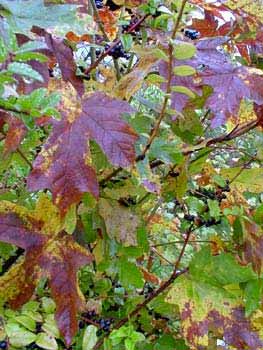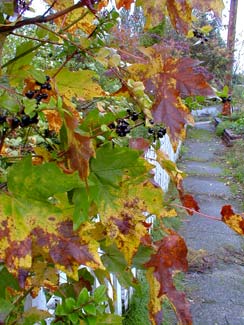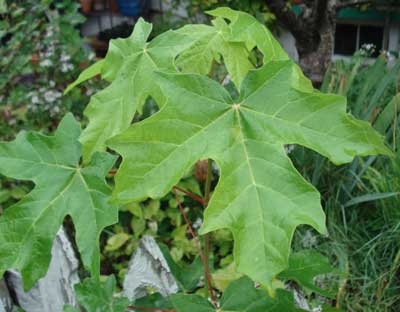
Bigleaf Maple; aka,
Oregon Maple
"Fierce burns our fire of driftwood; overhead
Gaunt maples lift arms against the night;
The stars are sobbing, - sorrow-shaken, white,
And high they hang, or show sad eyes grown red
With weeping for their queen, - the moon, just dead."
-Herbert Bashford
(1871-1928])
(1871-1928])
 The folks who have lived longest on our block have described the huge Bigleaf Maples that used to line our street, but which became dangerously rotted in their hearts from old age, so that the city took them down as public hazards. How tragic a loss!
The folks who have lived longest on our block have described the huge Bigleaf Maples that used to line our street, but which became dangerously rotted in their hearts from old age, so that the city took them down as public hazards. How tragic a loss!Acer macrophyllum seedlings erupt in gardens with fair regularity, virtually always in places they couldn't possibly be permitted to grow, like in the crack of a walkway, or up against the foundation of the house. One sprang up to six feet high in a single season, up against the fence shoving against the sidewalk.
Obviously this wasn't a place where it could be allowed to become a tree, as it would lift the sidewalk, push down the fence, & block the public right of way along the sidewalk. But I didn't have the heart to get rid of it right away, & before the year was out, it was about eight feet tall. The October photographs (first & second) show it as the leaves are turning golden & brown.
But I had eventually to cut it to the ground, though I made no attempt to dig out the root. So for three years following it has returned as a small shrub with enormous maple leaves. The third photo is from August (2009). Because I have cut it to the ground before each spring, it gets smaller each year, but remains startlingly healthy. Eventually it shall give up, but in the meantime I don't mind having this recurring giant maple as a recurring small & attractive scrub maple.
 When these first pop up as saplings, they unfortunately usually die if transplanted spring or any other time when they are not dormant. In late autumn when they are at rest, however, they do transplant well. Unfortunately I was never able to move this one, which immediately had its roots too entwined with nearby shrubs & under the sidewalk.
When these first pop up as saplings, they unfortunately usually die if transplanted spring or any other time when they are not dormant. In late autumn when they are at rest, however, they do transplant well. Unfortunately I was never able to move this one, which immediately had its roots too entwined with nearby shrubs & under the sidewalk.Bigleaf maple has no subspecies, few variant forms, & has not been much used to produce cultivars. A cultivar sold as "Seattle Sentinel" developed at Washington Park Arboretum in 1954 is unusually upright, fitting into narrow places where a regular Bigleaf Maple would too soon outgrow in width; it is available from select tree specialists. "Kimballiae" also from Washington Arboretum is something of a Giant Laceleaf, with very deeply cut leaves; it is much more slow growing than the species.
A natural variant form A. macrophyllum var. rubrum when re-leafing in April is momentarily bright red, which makes for an amazing contrast to the huge racemes of greenish yellow flowers that also flourish in April. It was developed as the cultivar 'Bigleaf Rubrum' by the University of California, Berkeley, at Blake Gardens, where specimens still grow, but I could not find it offered by any nursery, so that it appears that at present only 'Seattle Sentine' & 'Kimballiae' are offered by ornamental tree specialists, primarily in Oregon.
A fourth but no longer commercially grown cultivar was developed in Germany, called 'Tricolor' for its variegated leaf. Many more cultivars certainly could be developed if any grower would focus on this species, for the tree is quite varied across its range.
Bigleaf, Big-leaf, or Big Leaf Maple grows wild all along the Pacific coast from the southern coastal Alaska through British Columbia to southern California. It is one of the most common deciduous trees seen all around Puget Sound. It generally does not grow east of the Cascade Mountains or the Sierra Nevadas, where dry seasons have kept birds or people from extending its range.
In the nearby Olympic rainforest we see Bigleaf Maples draped with mosses, looking more like something one would expect to see in a Florida swamp. The species seems in general to attract glorious mosses more than do the majority of trees. One often sees the licorice fern (Polypodium glycyrrhiza) growing out of moss thick on the trunks of Bigleaf maples, as though the fern were an epiphyte.
Indiginous peoples tended to use naturally downed trees for all their wood needs, including fallen bigleaf maples. In their own languages, Bigleaf Maples were called Paddle Trees, for the hardwood made good canoe paddles, bowls, spoons, & other practical objects. The large leaves were used to wrap fish to enhance the flavor of the fish while cooking in layered firepits.
The Thompson band & the Nlaka'pamux & other of the first peoples harvested the samaras (moth-wing seeds), sprouted them, & ate them boiled. The sap was used to make a traditional sweet maple drink, the Native American soda pop of a bygone age before the coming of whites. The first whites adapting New England methods on this Northwest maple figured out that the sweet sap could be boiled down into pancake syrup, but because it takes up to 35 gallons of sap for a single gallon of syrup, it was never done commercially.
First peoples also used the inner bark dried & powdered as a soup thickener, or mixed with flour. "Threads" of the moist, pliable inner bark were used for basket-weaving or in the manufacture rough garments. The nectar-rich mauve flowers were eaten raw. The Saanich made a medicine from Bigleaf Maple which was supposed to be useful for soar throats & as a general tonic.
It was a preferred wood for the fire-pits of longhouses, because it burned cleanly without producing smoke. A wood that burned with little or no smoke was important, as there was no actual chimney between the firepit & the smoke-hole of a longhouse roof. Other woods sometimes filled the longhouse with smoke, the lack of chimneys being responsible for many eye problems of longhouse inhabitants, & Northwest first peoples came up with numerous herbal eye-washes such as could be brewed from Geum triforum roots or from the leaves & fruit of Snowberries.
It is today the only commercially vital maple of the Pacific Northwest, as large trees are harvested to make panelling, furniture veneer, or musical instruments, admired for its dark fine hardwood grain. There is also a market for the burls of the largest oldest specimens, which are used to make table-tops & folksy furniture with amazing black & amber whorls in the polished dense grain.
However, because the old trees do rot in the center, it is not a highly valued lumber tree, since the bigger the tree gets the less likely it will have good heartwood. So callous lumberjacks to this very day, without even a passing concern for the environment, cut them down willnilly just to get them out of the way of conifer lumber harvests, & then leave the bigleaf maples downed in clear-cuts. Stumps of fallen or harvested Bigleaf Maple produce hundreds of twigs that become lively "scrub maples" which do not generally become large trees but live for decades as enormous twiggy shrubs.
The whirly-seeds or double-winged samara, as well as spring's leaf-buds, are a major food source for squirrels, birds, & other wildlife. Deer, horses, & cattle commonly browse the leaves.
Despite rapid growth in optimal conditions, seedlings have been known to remain stunted for years, & some trees never exceed twenty feet of height. Even in conditions conducive to rapid growth, they will not flower or produce their moth-shaped seeds for ten to twenty years. In moist soil near rivers the tree can grow seventy to a hundred feet tall, & the oldest specimens can have nine-foot wide trunks. In open spaces it is stubbier, though still a very substantial tree, valued for providing shade in parks & along lanes.
No maple has larger leaves than Bigleaf Maple; they can measure up to a full foot width or 15 inches in length, with the majority of the leaves in the six to ten inch range. Leaf fall is finished by October's end, but a tree old enough to have fruit will keep the decorative winged samaras most of the winter, dispersing them a few at a time whenever there's a wind, from October to January. The leaves re-emerge late March & April, when they also produce long showy panicles of mauve flowers that will soon change into miniatures of the samaras, clinging to the tree all year.